Related Research Articles

The drum is a member of the percussion group of musical instruments. In the Hornbostel-Sachs classification system, it is a membranophone. Drums consist of at least one membrane, called a drumhead or drum skin, that is stretched over a shell and struck, either directly with the player's hands, or with a percussion mallet, to produce sound. There is usually a resonant head on the underside of the drum. Other techniques have been used to cause drums to make sound, such as the thumb roll. Drums are the world's oldest and most ubiquitous musical instruments, and the basic design has remained virtually unchanged for thousands of years.

The double bass, also known simply as the bass, amongst other names, is the largest and, therefore, lowest-pitched chordophone in the modern symphony orchestra. Similar in structure to the cello, it has four, although occasionally five, strings.

A percussion instrument is a musical instrument that is sounded by being struck or scraped by a beater including attached or enclosed beaters or rattles struck, scraped or rubbed by hand or struck against another similar instrument. Excluding zoomusicological instruments and the human voice, the percussion family is believed to include the oldest musical instruments. In spite of being a very common term to designate instruments, and to relate them to their players, the percussionists, percussion is not a systematic classificatory category of instruments, as described by the scientific field of organology. It is shown below that percussion instruments may belong to the organological classes of idiophone, membranophone, aerophone and cordophone.

A djembe or jembe is a rope-tuned skin-covered goblet drum played with bare hands, originally from West Africa. According to the Bambara people in Mali, the name of the djembe comes from the saying "Anke djé, anke bé" which translates to "everyone gather together in peace" and defines the drum's purpose. In the Bambara language, "djé" is the verb for "gather" and "bé" translates as "peace."
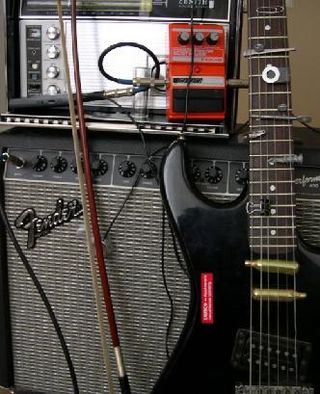
In music, extended technique is unconventional, unorthodox, or non-traditional methods of singing or of playing musical instruments employed to obtain unusual sounds or timbres.

The conga, also known as tumbadora, is a tall, narrow, single-headed drum from Cuba. Congas are staved like barrels and classified into three types: quinto, tres dos or tres golpes (middle), and tumba or salidor (lowest). Congas were originally used in Afro-Cuban music genres such as conga and rumba, where each drummer would play a single drum. Following numerous innovations in conga drumming and construction during the mid-20th century, as well as its internationalization, it became increasingly common for drummers to play two or three drums. Congas have become a popular instrument in many forms of Latin music such as son, descarga, Afro-Cuban jazz, salsa, songo, merengue and Latin rock.
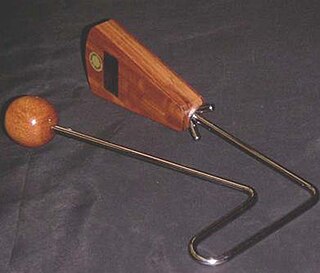
The vibraslap is a percussion instrument consisting of a piece of stiff wire connecting a wooden ball to a hollow box of wood with metal “teeth” inside. The percussionist holds the metal wire in one hand and strikes the ball. The box acts as a resonating body for a metal mechanism placed inside with a number of loosely fastened pins or rivets that vibrate and rattle against the box. The instrument is a modern version of the jawbone.

A cajón is a box-shaped percussion instrument originally from Peru, played by slapping the front or rear faces with the hands, fingers, or sometimes implements such as brushes, mallets, or sticks. Cajones are primarily played in Afro-Peruvian music, but have made their way into flamenco as well. The term cajón is also applied to other box drums used in Latin American music, such as the Cuban cajón de rumba and the Mexican cajón de tapeo.

A clap is the percussive sound made by striking together two flat surfaces, as in the body parts of humans or animals. Humans clap with the palms of their hands, often quickly and repeatedly to express appreciation or approval, but also in rhythm as a form of body percussion to match the sounds in music, dance, chants, hand games, and clapping games.
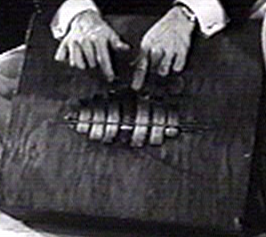
The marímbula is a plucked box musical instrument of the Caribbean. In Cuba it is common in the changüí genre, as well as old styles of son. In Mexico, where it is known as marimbol is played in son jarocho; in the Dominican Republic, where it is known as marimba, it is played in merengue típico, and in Jamaica it is known as rumba box and played in mento.
The hand jive is a dance particularly associated with music from the 1950s, rhythm and blues in particular. It involves a complicated pattern of hand moves and claps at various parts of the body, following and/or imitating the percussion instruments. It resembles a highly elaborate version of pat-a-cake. Hand moves include thigh slapping, crossing the wrists, fist pounding, hand clapping, and hitchhike moves.

Alberto Naranjo [nah-rahn'-ho] was a Venezuelan musician. His mother, the singer Graciela Naranjo, was a radio, film and television pioneer in her homeland. Largely self-taught, Naranjo embarked on a similar musical course, becoming – like his mother – one of Venezuela's icons of contemporary popular music.

The sintir, also known as the guembri (الكمبري), gimbri, hejhouj in Hausa language, is a three stringed skin-covered bass plucked lute used by the Gnawa people. It is approximately the size of a guitar, with a body carved from a log and covered on the playing side with camel skin. The camel skin has the same acoustic function as the membrane on a banjo. The neck is a simple stick with one short and two long goat strings that produce a percussive sound similar to a pizzicato cello or double bass.

The Juba dance or hambone, originally known as Pattin' Juba, is an African-American style of dance that involves stomping as well as slapping and patting the arms, legs, chest, and cheeks (clapping). "Pattin' Juba" would be used to keep time for other dances during a walkaround. A Juba dance performance could include steps such as the "Jubal Jew", "Yaller Cat", "Pigeon Wing" and "Blow That Candle Out".

Hand percussion is a percussion instrument that is held in the hand. They can be made from wood, metal or plastic, bottles stops and are usually shaken, scraped, or tapped with fingers or a stick. It includes all instruments that are not drums or pitched percussion instruments such as the marimba or the xylophone.
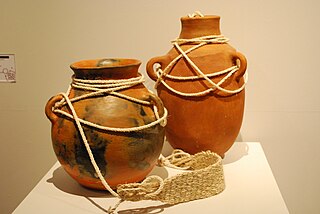
The cantaro is a percussion instrument. It is a clay pot that is struck in its outer surface or mouth with a hand, creating different effects. Water can be used to pitch the instrument to a desired sound.

A treshchotka is a Russian folk music idiophone percussion instrument which is used to imitate hand clapping. It consists of a set of small boards on a string that are clapped together as a group.
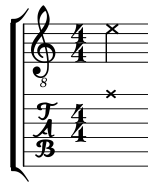
In music, notably in jazz, a ghost note is a musical note with a rhythmic value, but no discernible pitch when played. In musical notation, this is represented by an "X" for a note head instead of an oval, or parentheses around the note head. It should not be confused with the X-shaped notation that raises a note to a double sharp.
The Fa'ataupati is a dance indigenous to the Samoans. In English it is simply the "Samoan Slap Dance". It was developed in Samoa in the 19th century and is only performed by males.

The taal, manjira, jalra, karatala, kartal or gini is a pair of clash cymbals, originating in the Indian subcontinent, which make high-pitched percussion sounds. In its simplest form, it consists of a pair of small hand cymbals. The word taal comes from the Sanskrit word Tālà, which literally means a clap. It is a part of Indian music and culture, used in various traditional customs e.g. Bihu music, Harinaam etc. It is a type of Ghana vadya.
References
- ↑ Romero-Naranjo, F. J. (2013). "Science & art of body percussion: A review". Journal of Human Sport & Exercise. 8 (2): 442–457. doi: 10.4100/jhse.2012.82.11 – via Scopus.
- ↑ Romero-Naranjo, F.J. "Percusión corporal en diferentes culturas (Body percussion in different cultures)". Música y Educación (Music and Education). 76–2008: 46–96.
- ↑ Terry, Keith. "Body Music". World Arts West. Archived from the original on 2007-10-19. Retrieved 2008-02-13.
- ↑ Percussive Notes -1984 Volume 23 - Page 50 "Body music was probably the first music - before people began slapping rocks and hollowing logs for drums, they were probably stomping, clapping and grunting to express their musical ideas. There are many body musics still thriving today: in the United States hambone was popular at the turn of the century and is still in practice; some South Pacific island people create music by clapping and slapping the chest and thighs; in Morocco there is a version that involves beating the chest... These are only a few examples of a varied and vital body music scene...."
- ↑ Locklear, Scott (May 2006). "Body Percussion" (PDF). Drum!: 69–72. Archived from the original (PDF) on 2008-07-04. Retrieved 2008-02-13.
- ↑ [ dead link ]
- ↑ "Percusión Corporal y "Solfeo Cognitivo". Recursos pedagógicos según el Método BAPNE". Archived from the original on 2020-12-16. Retrieved 2021-01-19.
- ↑ [ dead link ]
- ↑ "Home". Percusion-corporal.com. Retrieved 20 April 2021.
- ↑ [ dead link ]
- ↑ "Barbatuques - Shows | Atividades Corporativas | Oficinas". Barbatuques.com.br. Retrieved 20 April 2021.